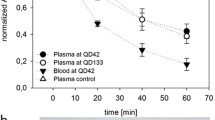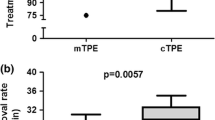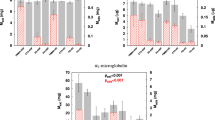Abstract
Background
The possibility of clearing Cell-free Plasma Hemoglobin (CPH) from human plasma may appear attractive, especially when considering the noxious effects that CPH has on the immune function and the renal damage caused by its filtration. The existence of the so-called High Cut-Off (HCO) filters, possessing pores as big as 60 kDa, could potentially allow the clearance of the αβ dimers (31.3 kDa), the form in which the α2β2 hemoglobin tetramers (62.6 kDa) physiologically dissociate in plasma. We present herein the first reported case in which such an attempt was made.
Case presentation
The patient was a 51-year-old man with hemolytic crisis due to glucose-6-phosphate dehydrogenase deficiency, further complicated by pigment-induced nephropathy. He underwent a 48-h CVVHD session, in which a HCO filter was used. The Sieving Coefficient (SC) for CPH was initially 0.08 and decreased to 0.02 after 24 h. This unexpected low SC was due to the initial high concentration of CPH (4.24 g/L). At such concentrations, the α2β2 tetramer poorly dissociates into the αβ dimer; but increases exponentially at concentrations lower than 1 g/L.
Conclusions
Clearance of CPH through a HCO filter is technically feasible but its performance markedly relies on the initial concentration of CPH. Critically ill patients with smoldering hemolysis, as it happens during septic shock or ECMO treatment, may benefit the most from the use of this membrane in order to clear CPH.
Similar content being viewed by others
Background
The presence of Cell-free Plasma Hemoglobin (CPH) in human plasma derives from the erythrocytes breakdown and depletion of haptoglobin, the plasmatic protein devoted to CPH scavenging. This usually occurs in massive hemolysis, in the context of which haptoglobin-binding capacity is exhausted and CPH is filtered by glomeruli. The glomerular filtration of hemoglobin can lead to pigmented-cast nephropathy, a fearsome complication that may require urgent hemodialysis [1]. Apart from the cases of massive hemolysis, CPH can also be found in acutely ill patients with compromised liver function because of a decreased production of haptoglobin as well as in patients undergoing extracorporeal treatments like hemodialysis and ECMO. In these cases, the CPH concentration is just slightly higher with respect to the physiological levels and is unable to cause significant kidney damage. However, CPH presents some toxic effects even at low levels, since it alters the pathogen-induced inflammatory response. Animal models have demonstrated that lipopolysaccharide (LPS)-induced release of TNF-α is increased after exposure to CPH [2, 3]. Moreover, a clinical study clearly demonstrated that CPH is a strong predictor of mortality in septic patients [4]. Therefore, the possibility to dialyze CPH in septic patients may represent an intriguing topic of research in the next future. Recently, an in-vitro proof-of-concept model demonstrated that a High-Cut Off (HCO) hemofilter with pores of 60 kDa diameter is able to dialyze the αβ hemoglobin dimer, whose molecular weight is 31.3 kDa [5]. The dimer is that part of the hemoglobin molecule that is actually filtered by the glomerulus and that eventually causes pigmented-cast nephropathy [6]. The tetramer composed by two α and two β subunits, which is the physiological carrier of oxygen within erythrocytes, weighs instead 62.6 kDa; this is scarcely filtered by the glomerulus and by HCO filters. Thus, clearance of CPH depends on the dissociation degree of Hb tetramers into dimers. To the best of our knowledge, we report the first case of a patient with massive hemolysis and Acute Kidney Injury (AKI) treated with a HCO filter that allowed us to verify the possibility to clear CPH in-vivo from human plasma.
Case presentation
A 51-year-old man presented to the emergency department with fever, abdominal pain and jaundice. Past and recent medical history were unremarkable and the patient did not report any recent trip, risky sexual behaviour, parenteral drug intake or ingestion of potentially contaminated food. The physical examination revealed right hypochondrium and epigastric tenderness and no signs of peritonitis. Lab tests showed Aspartate AminoTransferase (AST) 3560 UI/L, Alanine AminoTransferase (ALT) 4513 UI/L, hyperbilirubinemia (total 16 mg/dL), alkaline phosphatase, GGT 90/418 UI/L, PT 50%, normal pancreatic enzymes and normal renal function. Abdominal ultrasound showed no alterations.
Twenty-four hours after the admission, liver function rapidly declined, with PT 40% and maximum total bilirubin of 47 mg/dL. In parallel, blood test showed an elevation of LDH, haptoglobin consumption, reticulocytosis and AKI stage 3 with creatinine of 4 mg/dL and a peripheral blood smear suggestive of hemolysis. Urinalysis was positive for bilirubin and hemoglobin, while the urinary sediment discarded the presence of red blood cells. Serological tests were positive for IgM Hepatitis A Virus (HAV). In addition, a previously unknown complete glucose-6-phosphate dehydrogenase deficiency was detected.
On the basis of these findings a diagnosis of acute hepatitis A infection complicated with massive hemolysis due to glucose-6-phosfate dehydrogenase deficiency was done. Hemolysis was probably triggered by fitomenadione administration and its diagnosis was partially masked by high bilirubin levels due to the severe hepatitis. AKI was interpreted as the result of pigmented-cast nephropathy. The haemolytic crisis was initially managed with 2 sessions of plasma exchange. However, considering the need of dialysis and the presence of CPH, continuous renal replacement treatment with a HCO filter (Septex™, 1.1m2, Gambro-Baxter, Hechingen, Germany; Fig. 1) in CVVHD modality was started. In order to measure the CPH clearance, plasma was collected in EDTA tubes from arterial, venous and dialysate ports of the CRRT circuit and CPH was measured with Drabkin-based spectrophotometric analysis at 540 nm. The Sieving coefficient (SC) was calculated as CD/[CIn + COut)/2] where CD, CIn and COut represent CPH concentration at the dialysate, blood inlet and blood outlet side. CPH clearance was calculated as {CD/[CIn + COut)/(2)]}Qe, where Qe is the effluent flow. This filter was used for 48 h, observing a CPH value of 4,24 g/L at the beginning and of 3,72 g/L at the end of the treatment. The calculated SC for CPH was 0.08 at treatment start, later decreasing to 0.02 after 24 h. The calculated clearance of CPH declined as well, from 2,87 ml/min on the first day to 0,76 ml/min after 24 h (Table 1 for treatment data and CPH clearance profile, Table 2 for common laboratory data before and after CVVHD treatment).
After this treatment, as the patient was still oliguric, seven sessions more of intermittent hemodialysis were performed. Eventually, 4 weeks after admission urine output ensued and the patient’s renal function started to recover. At the time of discharge, total bilirubin was 3.4 mg/dL and creatinine 2.8 mg/dL. Finally, 3 months after discharge the patient presented normal renal and hepatic function.
Discussion and conclusions
To the best of our knowledge, we report the first case of in-vivo CPH clearance by means of HCO-based CVVHD treatment. HCO filters have been designed to improve clearance of middle-sized molecules that were not previously cleared by normal filters, such as pro- and anti-inflammatory cytokines [7,8,9,10]. The possibility to clear CPH has been recently examined in an in-vitro model, in which the authors demonstrated the efficacy of the same HCO filter that we used, with a SC for CPH of 0.35 and a clearance of approximately 22 ml/min [5]. However, in our case the initial SC was of only 0.08, decreasing to 0.02 in the following 24 h, presumably due to the phenomenon of protein-coating. CPH clearance was reduced as well, with values below 3 ml/min initially: albeit not negative, this clearance is far from being clinically relevant. In order to explain the striking difference with the results obtained in the in-vitro model, we should consider the dissociation characteristics of the hemoglobin tetramers (62.6 kDa) into dimers (31.3 kDa). Indeed, the hemoglobin dimer is the part of the molecule that is cleared by the HCO filter under study, whose cut-off is 60 kDa. As the dissociation of tetramers into dimers is maximum at low concentrations of CPH, the best results are obtained with CPH concentrations lower than 1 g/L. In the above-cited in-vitro study, indeed, the CPH concentration was within this range and the approximate dissociation degree at this concentration was around 40%. On the other side, our patient had much higher CPH concentration (4.24 g/L). At this level, the expected dissociation degree is lower than 10% [5]. Therefore, the lower SC for CPH observed in our case is probably due to the lesser degree of dissociation of the molecule. This point provides an important indication, since it demonstrates that those patients that would benefit the most from this treatment are those presenting CPH levels lower than 1 g/L. Presumably, patients with massive hemolysis and already established kidney injury are less likely to benefit from HCO-based CPH clearance. On the other side, critically ill patients with smoldering hemolysis and lower concentrations of CPH should theoretically take more advantage from it. For example, pediatric patients submitted to two different types of ECMO treatment had mean CPH values between 0.36 and 0.58 g/l [11], while CPH values in septic patients ranged from 0.034 to 0.185 g/L [4]. It is worthy to underline that even these low levels of CPH are not harmless. In a rat model, purified hemoglobin enhanced TNF-α synthesis in LPS-stimulated macrophages by a factor of 1.000 [2]. In another model, the administration of hemoglobin in LPS-treated mice resulted in an increase in TNF-α levels and mortality [3]. In humans, CPH was strongly associated with decreased survival in severe septic patients, even after substantial correction with already known risk factors including age, inflammatory biomarkers, Simplified Acute Physiology (SAPS-II) and Sequential Organ Failure Assessment (SOFA) scores [4].
Conclusion
In conclusion, we report the case of a patient treated with a HCO-based CRRT treatment for the clearance of CPH. The lower than expected SC was probably due to the low dissociation of the hemoglobin tetramers into dimers, as a consequence of the high concentrations of CPH in our patient. Therefore, we might infer that those patients that would benefit the most from this kind of treatment are the critically ill ones with low levels of CPH in the context of septic shock or extracorporeal treatments like ECMO. Even at these low levels, CPH has well-documented harmful effects on the immune system. The possibility to clear CPH in these patients may not represent only a “cosmetic” intervention, but may also be beneficial in blunting the inflammatory response.
Abbreviations
- AKI:
-
Acute Kidney Injury
- ALT:
-
Alanine AminoTransferase
- AST:
-
Aspartate AminoTransferase
- CRRT:
-
Continuous Renal Replacement Therapy
- CVVHD:
-
Continuous Veno-Venous HemoDialysis
- ECMO:
-
Extracorporeal Membrane Oxygenation
- HAV:
-
Hepatitis A Virus
- HCO:
-
High-Cut Off
- LPS:
-
lipopolysaccharide
- SAPS-II:
-
Simplified Acute Physiology Score II
- SOFA:
-
Sequential Organ Failure Assessment
- TNF-α:
-
Tumor Necrosis Factor Alfa
References
Shih HM, Chen YC, Pan CF, Lin HC, Wu CJ, Chen HH. Hemolysis-induced acute kidney injury following cardiac surgery: a case report and review of the literature. Hemodial Int. 2013;17(1):101–6.
Bloom O, Wang H, Ivanova S, Vishnubhakat JM, Ombrellino M, Tracey KJ. Hypophysectomy, high tumor necrosis factor levels, and hemoglobinemia in lethal endotoxemic shock. Shock. 1998;10(6):395–400.
Su D, Roth RI, Levin J. Hemoglobin infusion augments the tumor necrosis factor response to bacterial endotoxin (lipopolysaccharide) in mice. Crit Care Med. 1999;27(4):771–8.
Adamzik M, Hamburger T, Petrat F, Peters J, de Groot H, Hartmann M. CPH concentration in severe sepsis: methods of measurement and prediction of outcome. Crit Care. 2012;16(4):R125.
Hulko M, Kunz M, Yildirim M, Homeyer S, Amon O, Krause B. Cell-free plasma hemoglobin removal by dialyzers with various permeability profiles. Sci Rep. 2015;5:16367.
Bunn HF, Esham WT, Bull RW. The renal handling of hemoglobin. I. Glomerular filtration. J Exp Med. 1969;129(5):909–23.
Haase M, Bellomo R, Baldwin I, et al. Hemodialysis membrane with a high-molecular-weight cutoff and cytokine levels in sepsis complicated by acute renal failure: a phase 1 randomized trial. Am J Kidney Dis. 2007;50(2):296–304.
Morgera S, Klonower D, Rocktäschel J, et al. TNF-alpha elimination with high cut-off haemofilters: a feasible clinical modality for septic patients? Nephrol Dial Transplant. 2003;18(7):1361–9.
Morgera S, Haase M, Rocktäschel J, et al. High permeability haemofiltration improves peripheral blood mononuclear cell proliferation in septic patients with acute renal failure. Nephrol Dial Transplant. 2003;18(12):2570–6.
Morgera S, Haase M, Kuss T, et al. Pilot study on the effects of high cutoff hemofiltration on the need for norepinephrine in septic patients with acute renal failure. Crit Care Med. 2006;34(8):2099–104.
Cornelius AM, Riley JB, Schears GJ, Burkhart HM. Plasma-free hemoglobin levels in advanced vs. conventional infant and pediatric extracorporeal life support circuits. J Extra Corpor Technol. 2013;45(1):21–5.
Acknowledgements
We thank Benedetta Varisco for her careful revision of the manuscript.
Availability of data and materials
Data and material supporting our findings are present in the hospital records and are available upon request after de-identification of patients’ information.
Author information
Authors and Affiliations
Contributions
DC, ER, MB, JF and EP contributed to the conception of the study, AMA, AC, MS and AE have been involved in drafting of the manuscript, JF and EP critically revised the manuscript for important intellectual content. All the authors have read and approved the final version of the manuscript, and ensure that this is the case.
Corresponding author
Ethics declarations
Ethics approval and consent to participate
Not applicable.
Consent for publication
Written informed consent covering the publication of personal and medical information of the patient has been obtained before submission of the manuscript and is available upon request.
Competing interests
The authors declare that they have no competing interests.
Publisher’s Note
Springer Nature remains neutral with regard to jurisdictional claims in published maps and institutional affiliations.
Rights and permissions
Open Access This article is distributed under the terms of the Creative Commons Attribution 4.0 International License (http://creativecommons.org/licenses/by/4.0/), which permits unrestricted use, distribution, and reproduction in any medium, provided you give appropriate credit to the original author(s) and the source, provide a link to the Creative Commons license, and indicate if changes were made. The Creative Commons Public Domain Dedication waiver (http://creativecommons.org/publicdomain/zero/1.0/) applies to the data made available in this article, unless otherwise stated.
About this article
Cite this article
Cucchiari, D., Reverter, E., Blasco, M. et al. High cut-off membrane for in-vivo dialysis of free plasma hemoglobin in a patient with massive hemolysis. BMC Nephrol 19, 250 (2018). https://doi.org/10.1186/s12882-018-1051-x
Received:
Accepted:
Published:
DOI: https://doi.org/10.1186/s12882-018-1051-x





